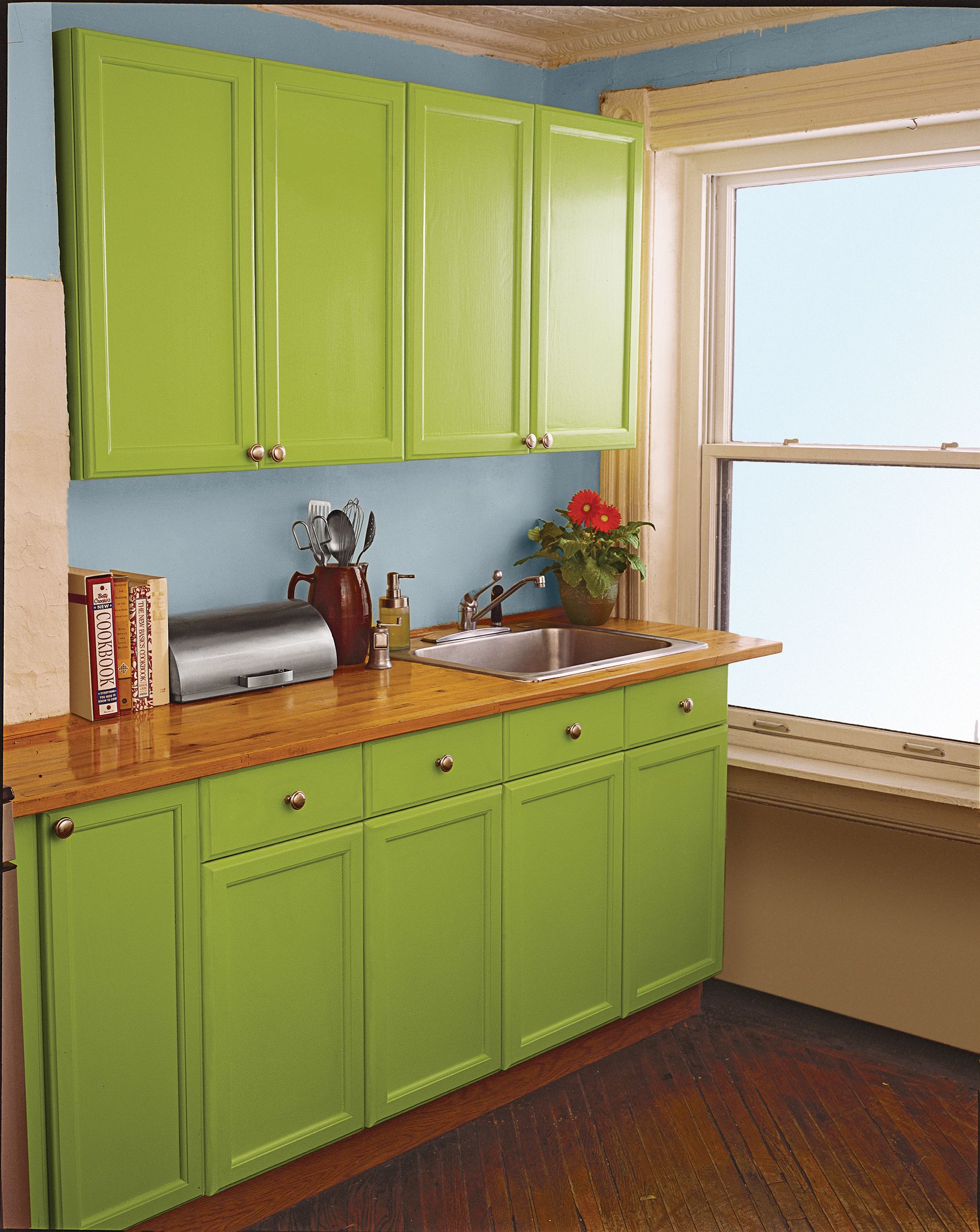Updating your kitchen cabinets doesn’t always require a complete overhaul. There are many ways to refresh your existing cabinets without the expense and hassle of replacement. From simple paint jobs to more involved DIY projects, these 10 ideas will help you transform your kitchen’s look and functionality.
1. Paint Kitchen Cabinets
One of the most impactful and cost-effective ways to update your kitchen cabinets is with a fresh coat of paint. This simple change can dramatically alter the entire look and feel of your kitchen. If your current cabinets are dark and make your kitchen feel cramped, consider painting them in a lighter shade to open up the space.
Before you begin, ensure your cabinets are structurally sound, clean them thoroughly, and follow proper painting techniques for the best results. You can refer to How To Paint Kitchen Cabinets for our comprehensive guide on painting your kitchen cabinets.
Color makes a big difference, but color with a little flair can change the style of your cabinets from plain and simple to shabby chic, rustic, provincial, or modern. Here are a few of our favorite faux finishes that can spice up your kitchen’s style.
Crackle
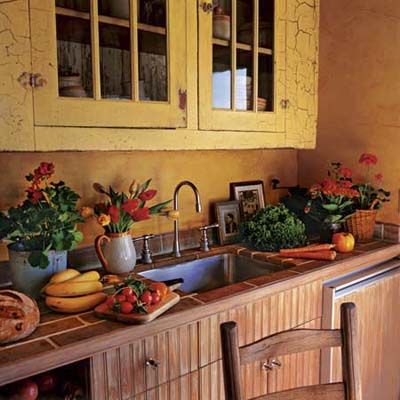
The crackle technique creates a weathered, antique look that can add character to your kitchen. This effect is achieved using a special crackling glaze available at most paint stores. To create this finish, follow the steps below:
- Apply a base coat and allow it to dry completely.
- Brush on the crackling glaze in one direction, applying it thickly for large cracks or thinly for fine cracks.
- Once dry, apply a flat top coat of the base color, brushing perpendicular to the glaze.
- Watch as the paint begins to crack, creating an aged appearance within about an hour.
Distressed
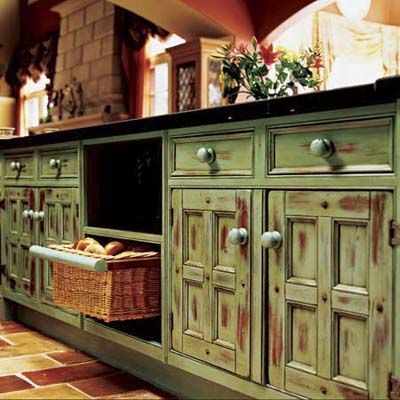
A distressed finish gives your cabinets a rustic, well-worn look that’s perfect for farmhouse or cottage-style kitchens. This technique involves the following steps:
- Apply multiple layers of paint in different colors.
- Use sandpaper to reveal underlying colors in high-use areas.
- Add dark paint splatters to mimic natural wear and tear.
- Gently hit the surface with a chain to create authentic-looking dents and dings.
Antiqued
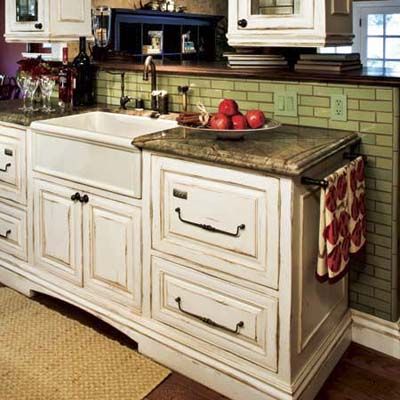
An antiqued finish evokes a sense of history and charm. Here’s how to create this provincial look:
- Paint your cabinets in your chosen base color.
- Once dry, use a brush dipped in a lighter color paint.
- Dab most of the paint off onto a cloth until the brush is nearly dry.
- Lightly graze the surface of detail trim, corners, and seams to create subtle highlights.
High Gloss
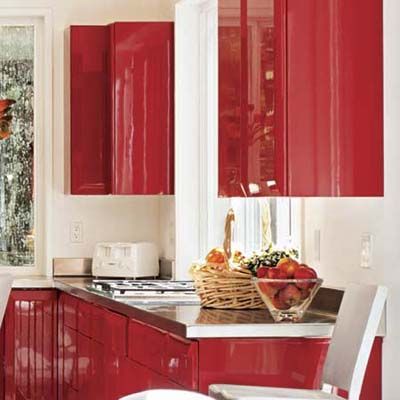
For a modern, sleek look, consider a high-gloss finish. This technique not only looks great but also offers practical benefits. To achieve this look, apply your chosen paint color to the cabinets. Once dry, add a layer of high-gloss clear acrylic varnish. This finish is easier to clean and more resistant to fingerprints than matte finishes. The reflective surface can help brighten your kitchen and make it feel more spacious.
2. Reface Kitchen Cabinets
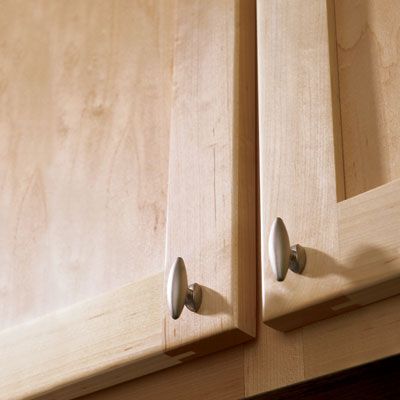
Refacing your kitchen cabinets is an excellent middle ground between painting and full replacement. This process involves applying new veneer to the existing cabinet boxes and replacing the doors and drawer fronts. Refacing can give your kitchen a completely new look without the high cost of new cabinets.
For step-by-step instructions and a list of tools needed, see How To Reface Kitchen Cabinets. Here’s a quick overview of the steps to reface your cabinets:
- Remove old doors, drawer fronts, and hardware.
- Clean and sand the cabinet boxes.
- Apply new veneer to the cabinet boxes.
- Install new doors and drawer fronts.
- Add new hardware for a finishing touch.
3. Install a Pull-Out Cabinet Shelf
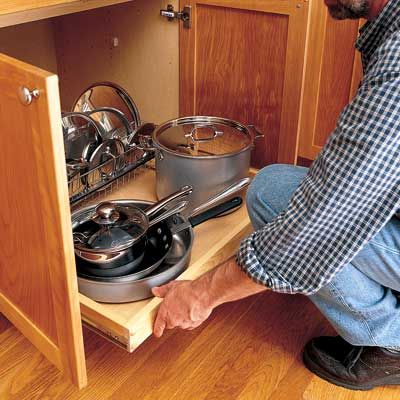
Maximize your kitchen’s storage potential by installing pull-out shelves in your base cabinets. These shelves function like shallow drawers, sliding out for easy access to items stored at the back of the cabinet. This simple addition can significantly improve the functionality of your kitchen storage.
Our recommended shelf design is suitable for a standard 24-inch-deep by 33-inch-wide base cabinet, but it can be adapted to fit most cabinet sizes. The shelf consists of a 1×4 pine frame and a 3/4-inch birch plywood bottom. If you’re only building one or two shelves, consider purchasing a quarter or half sheet of plywood to save on costs.
For those new to woodworking, don’t be intimidated. This project has been designed with simplicity in mind and can be completed using ordinary tools. Read How To Install a Pull-Out Cabinet Shelf for step-by-step instructions and a list of tools needed.
4. Put in Undercabinet Lighting
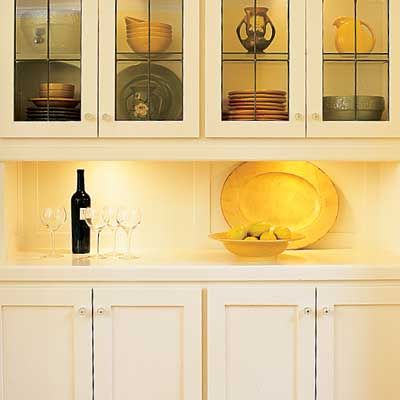
Undercabinet lighting is the missing element in many kitchens. These hidden fixtures provide essential task lighting, illuminating your countertops and making food preparation easier and safer. They also add ambiance to your kitchen, especially when connected to a dimmer switch.
Installing undercabinet lighting is a relatively simple DIY project that can dramatically improve your kitchen’s functionality and aesthetics. Choose between LED, fluorescent, or halogen options based on your preferences and budget, and decide on hardwired or plug-in options depending on your electrical setup. Consider adding a dimmer switch for versatility.
Measure the length of your cabinets to determine how many fixtures you’ll need, and check out our video walkthrough on How To Install Undercabinet Lighting, which includes safety precautions and wiring instructions.
5. Build a Butcher Block Island to Replace Cabinets
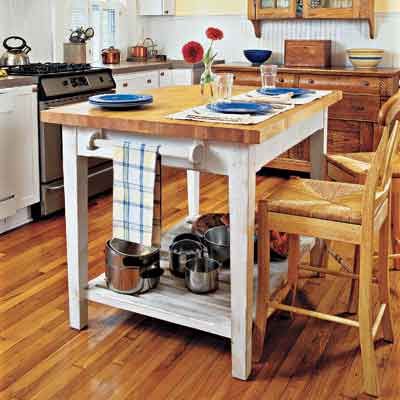
A butcher block island can add warmth and functionality to your kitchen. These sturdy work surfaces, reminiscent of 19th-century worktables, are perfect for food preparation and can soften the look of modern kitchens with stone counters and metal appliances. Butcher block islands offer several advantages:
- Aesthetics: The natural wood grain adds character and warmth to your kitchen.
- Durability: The exposed edge or end grain makes them resistant to warping and nicks.
- Versatility: They can be used for food prep, dining, or as a casual workspace.
You can either construct a butcher block island yourself using readily available materials or choose from various pre-made options. For those interested in a DIY approach, our step-by-step guide on How To Build a Butcher Block Island provides detailed instructions and a materials list.
6. Build a Sideboard from Kitchen Cabinets
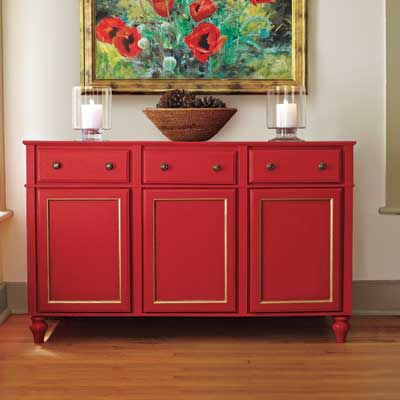
A sideboard is a versatile piece of furniture that can add storage and style to your kitchen or dining area. While high-quality, ready-made sideboards can be expensive, you can create a custom piece using stock kitchen cabinets at a fraction of the cost.
This project can typically be completed in a day and results in a beautiful, functional piece of furniture. For detailed instructions on how to transform stock cabinets into a custom sideboard, refer to our guide on How To Build a Sideboard from Stock Cabinets. Here’s a quick overview of the steps:
- Choose unfinished 15- or 18-inch base cabinets with doors and functional drawers.
- Enhance the cabinets with decorative molding and furniture feet.
- Add knobs or handles that complement your kitchen’s style.
- Paint or stain the sideboard to match your decor.
7. Build a Built-In Cabinet Window Seat
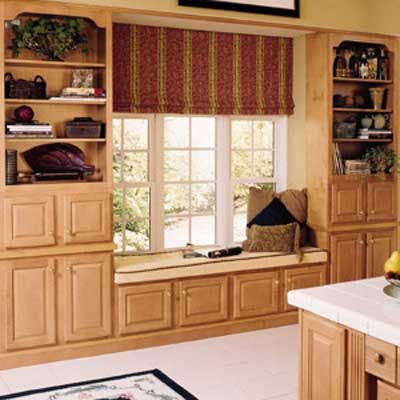
A window seat can add charm and extra storage to your kitchen. While traditionally found in older homes with deep dormers, you can create a similar feature in any kitchen with a window. This DIY project combines stock cabinets and bookcases to create a cozy seating area with ample storage underneath.
This design can be adapted to fit windows of various sizes. For a complete guide on how to construct a window seat, including materials needed and step-by-step instructions, check out our article on How To Build a Window Seat. Here’s a look at the steps:
- Use a combination of kitchen wall cabinets and bookcase units as the base.
- Top the cabinets with over-the-refrigerator cabinets to create the seat.
- Add crown molding for a finished look.
- Install a cushion on top for comfort.
8. Add a Plate Rack With Your Kitchen Cabinets
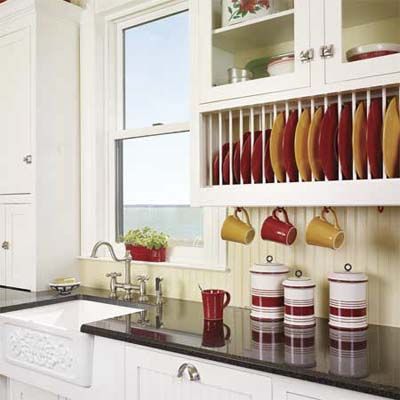
A plate rack is a practical and decorative addition to your kitchen cabinets. It allows you to display attractive dishes while freeing up valuable cabinet space. This feature can add a pop of color to your kitchen and make frequently used items more accessible.
To add a plate rack, follow the steps below:
- Choose a location, typically above a counter or sink.
- Measure the space and select a plate rack kit that fits.
- Install the rack according to the kit instructions.
- Arrange your dishes for both functionality and visual appeal.
To learn how to install a plate rack and other DIY kitchen upgrades, refer to our article on Stylish Kitchen Upgrades From DIY Kits.
9. Add Cabinet Crown Molding
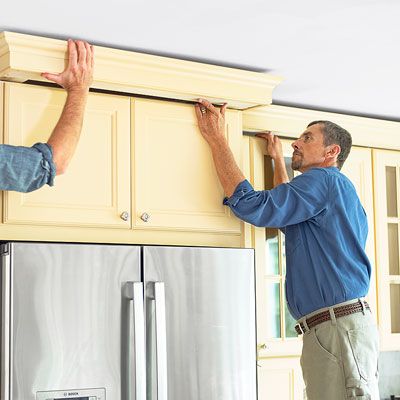
Crown molding can elevate the look of your kitchen cabinets, giving them a custom, high-end appearance. This relatively simple addition can transform your kitchen’s aesthetic, making it look more polished and cohesive.
To add crown molding to your cabinets, follow these steps:
- Measure the length of your cabinet tops.
- Cut the molding to size, accounting for corner joints.
- Create a frame to attach the molding to, making installation easier.
- Attach the molding to the frame, then install the entire assembly above the cabinets.
This method allows you to do most of the detail work on a workbench rather than on a ladder, making the process safer and more precise. For a detailed guide on how to install cabinet crown molding, including tips for dealing with uneven ceilings, watch our video on How To Install Kitchen Cabinet Crown Molding.
10. Add Storage With More Kitchen Cabinets
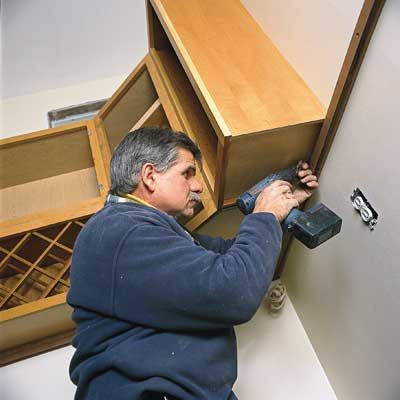
Sometimes, the best way to update your kitchen is simply to add more storage. Installing additional cabinets can help reduce clutter and improve your kitchen’s functionality. While custom cabinets were once the norm, today’s manufactured cabinets offer quality and affordability.
When adding new cabinets, measure your space carefully to ensure a proper fit. Choose cabinets that complement your existing ones in style and color. During installation, ensure everything is level, plumb, and square. Consider adding special features like pull-out shelves or built-in organizers.
The goal is to create a cohesive look that appears built-in and intentional. For a comprehensive guide on how to install kitchen cabinets, including tips for dealing with uneven walls and floors, refer to our article on How To Hang Kitchen Cabinets.
